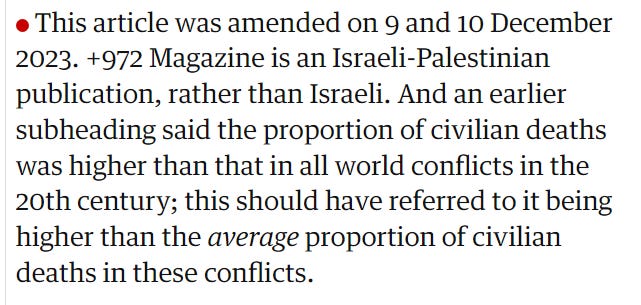Let’s not debase a terrible tragedy with nonsense and inflame a combustible situation with carelessness
Because journalism is muchly about clickbait these days, there has been some unserious reporting around the serious issue of the civilian casualties caused by Israel’s operation to uproot the Hamas militia from power in Gaza.
Every civilian death is a tragedy (of course!) – yet people do understand that some wars are just and that even such wars will cause some civilian deaths. That goes double for conflicts provoked by fanatical and nihilistic terrorists using human shields and operating from apartment buildings, schools, mosques and hospitals.
I’ve taken the position that after the Oct. 7 Hamas invasion of Israel, which according to eyewitness and evidence included gang rapes and torture and burning alive entire families and led to 1,200 Israeli deaths, the group must be crushed. It’s not an especially original, strange or rare position, but it has attracted the ire of some friends around the region – who see nothing but the resultant civilian casualties in Gaza.
At the same time, I have been appearing on American and Israeli TV urging everyone to show restraint and to distinguish between the 2 million people of Gaza and the terrorist criminals who in 2007 expelled the Palestinian Authority from the seaside strip and took its population hostage. Moreover, I have repeatedly urged Israel to minimize civilian casualties and to better explain actions that caused lives to be lost (most recently today, below). Earlier I argued that Israel should exhaust every option before an invasion of the strip. All that earned ire as well.
I don’t think it is insensitive to say accuracy should be a goal and that tragedies require no embellishment to be appreciated with appropriate horror. The question how many people have been killed, and the contextualization of it, determine attitudes and feed narratives that could end up enabling Hamas to remain in power, to the detriment of Israelis, Palestinians, the region and the world.
For sobriety to prevail, we must turn for information not to partisan announcements, context-free anecdotes or social media but rather to the news media (as I argued on these pages). Specifically to the careful and serious media, financially troubled yet critically essential in my view.
So it is dispiriting to find that the latest case of carelessness coming from the normally sober Guardian, which on Dec. 9 claimed “data suggests” that the civilian proportion of deaths in Gaza was 61% and as such “is higher than the average in all world conflicts in the 20th century.” That’s right – “all” of the conflicts in what was a rather combustible century.
The Dec. 9 article based this assertion on another article published in the liberal Israeli newspaper Haaretz on Dec. 6. There are a number of issues there:
First, the Gaza figures in Haaretz included the situation only until October 27, less than three weeks after the war began – meaning that at the time of publication they covered about a third of the war’s timeframe to that point, and not necessarily the most representative part of it. The important question of whether the proportions continued was not addressed in either article.
Second, the figures cited by Haaretz writer Yagil Levy come from a report issued by the Hamas-run Health Ministry in Gaza. Hamas is an Islamic fundamentalist terrorist group whose raison d’etre is preventing a peaceful partition of the Holy Land; its charter calls for the elimination of Israel, but makes no mention of transparency and truth in its dealings with the infidel media. So some people doubt the figures, considering Hamas has incentive to inflate them so as to build pressure on Israel to halt the campaign before its completion. Levy actually made the point that the ministry has tended to be accurate in the past; the Guardian glossed over the question.
Which brings us to the most critical thing: the breakdown is at best an estimate. Levy conceded that he had no knowledge of who was a combatant, and the health ministry report made no distinction. So he applied assumptions: non-combatants were anyone under 18, men over 60, and all women. These assumptions are reasonable but far from always true. On the other hand, there’s no reason to assume that men between 18 and 60 were all combatants. The real proportion may be higher than 61% – or lower.
Indeed, the figure Haaretz reached includes yet another assumption from another article: that 10% of the rockets fired at Israel from Gaza landed in the strip, potentially causing casualties. To account for that the civilian casualties attributed to Israel were reduced somewhat, even though we cannot in fact know exactly how many people died in Gaza from failed Hamas rocket launches.
And so, with all due respect (and I mean that with precision), any figure from 40% to 75% could be justified by a plausible tweaking of the assumptions. Not to concede this is unserious, but perhaps not malpractice. What is malpractice comes next.
The Haaretz story made reference to a New York Times story from Nov. 25 that enjoyed more solid footing; rather than the maze of assumptions it simply looked at the total figures at that moment and compared them to absolute numbers of overall casualties in Mosul during the war to evict ISIS, or to “women and children” killed in the Ukraine war or in Afghanistan. It cited experts saying that the current pace was high, but also that Gaza is far more densely populated. Fair enough.
Levy himself made a halfhearted attempt to compare Gaza to previous conflicts also, and this is what he wrote on that, referencing the largely random 61% figure: „From an international comparative point of view, this is a high figure given that in the new wars until the 1990s, about half of the casualties were civilians, and we are talking about wars in which an important element was fighting from the ground, and not relatively precise attacks from the air.” No definition of “new wars.” was offered.
From this hodgepodge the Guardian managed to conclude that the proportion discussed was higher than in all the world conflicts in the 20th century. Two days later the Guardian published a correction saying this: „An earlier subheading said the proportion of civilian deaths was higher than that in all world conflicts in the 20th century; this should have referred to it being higher than the average proportion of civilian deaths in these conflicts.”

Readers might conclude that they have stumbled upon a monumental research project that surely includes World War II, where actually serious analysis (published by the National WWII Museum) shows about 75% of the 60 million deaths were civilian. And also that it would factor in World War I, the Armenian Genocide, the Brunei Revolt, the Korea and Vietnam wars, Russia’s civil war and the Boer wars, to name a subset.
And yet the article cited no source other than the Haaretz article, the NYT article and a Gaza-focused article in the Israeli-Palestinian 972 website. A mystery!
Perhaps I can clear it up. I hope the reader will allow me to offer a tip, as a former insider who spend decades as a foreign correspondent: Beware of headlines whose operative verb is “suggests,” for they are the wobbly crutches of lazy hacks seeking “eyeballs.” I’m not suggesting this. I’m saying it.

















